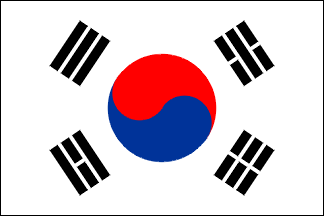Republic of Korea" and "ROK" redirect here. For the Democratic People's Republic of Korea, see North Korea. For other uses, see ROK (disambiguation).South Korea ( listen), officially the Republic of Korea (Hangul: 대한민국; Hanja: 大韓民國; Daehan Minguk
listen), officially the Republic of Korea (Hangul: 대한민국; Hanja: 大韓民國; Daehan Minguk  listen, "The Republic of GreatHan"; ROK), and commonly referred to as Korea, is a sovereign state in East Asia, constituting the southern part of the Korean Peninsula.[6] The name Korea is derived from the Kingdom of Goryeo, also spelled as Koryŏ. It shares land borders with North Korea to the north, and oversea borders with Japan to the east and China to the west. Roughly half of the country's 50 million people reside in the metropolitan area surrounding its capital, the Seoul Capital Area, which is the third largest in the world[7] with over 25 million residents.[8]
listen, "The Republic of GreatHan"; ROK), and commonly referred to as Korea, is a sovereign state in East Asia, constituting the southern part of the Korean Peninsula.[6] The name Korea is derived from the Kingdom of Goryeo, also spelled as Koryŏ. It shares land borders with North Korea to the north, and oversea borders with Japan to the east and China to the west. Roughly half of the country's 50 million people reside in the metropolitan area surrounding its capital, the Seoul Capital Area, which is the third largest in the world[7] with over 25 million residents.[8]
大韓民國(韓語:대한민국/大韓民國 Daehan Minguk)是位於東亞朝鮮半島南部的民主共和國,簡稱韓國(한국/韓國 Hanguk),或稱為南韓(남한/南韓),首都為首爾。韓國三面環海,西南瀕臨黃海(韓國又稱「西海」),東南是朝鮮海峽,東邊是日本海(韓國稱「東海」),北面隔著三八線南北韓非軍事區與朝鮮民主主義人民共和國相鄰,總面積10.02萬平方公里(占朝鮮半島總面積的4/9),人口約5,000萬[7]。
泡菜Kimchi
Kimchi (hangul: 김치 Korean pronunciation: [kimtɕʰi]; English pronunciation: /ˈkɪmtʃi/), also spelled kimchee or gimchi, is a traditional fermentedKorean side dish made of vegetables with a variety of seasonings. It is often described as spicy and sour.[1][2][3] In traditional preparation, kimchi is often allowed to ferment underground in jars for months.[4] There are hundreds of varieties of kimchi made from napa cabbage, radish,scallion, or cucumber as a main ingredient.
[5]泡菜古稱葅,是指為了利於長時間存放而經過發酵的蔬菜。一般來說,只要是纖維豐富的蔬菜或水果,都可以被製成泡菜;像是捲心菜、大白菜、紅蘿蔔、白蘿蔔、大蒜、青蔥、小黃瓜、洋蔥等。蔬菜在經過醃漬及調味之後,有種特殊的風味,許多人會當作是一種常見的配菜食用。所以現代人在食材取得無虞的生活環境中,還是會製做泡菜。世界各地都有泡菜的影子,風味也因各地做法不同而有異。已製妥的泡菜有豐富的乳酸菌,可幫助消化。若是誤食遭到污染的泡菜,容易拉肚子或是食物中毒。

N Seoul TowerN首爾塔
The N Seoul Tower, (Hangul: N서울타워), officially the YTN Seoul Tower[1] and commonly known as the Namsan Tower or Seoul Tower, is acommunication and observation tower located on Namsan Mountain in central Seoul, South Korea. At 236m, it marks the highest point in Seoul.[2]
Built in 1971, the N Seoul Tower is Korea's first general radio wave tower, providing TV and radio broadcasting in Seoul.[3] Currently, the tower broadcast signals for Korean media outlets, such as KBS, MBC and SBS.
N首爾塔(韓語:엔 서울타워,英語:N Seoul Tower,俗稱首爾塔、南山塔)位於韓國首爾特別市龍山區的南山,高236.7米,建於1975年,是集旅遊觀光和電視發射為一體的地標建築,鄰近南山纜車站。
辣炒年糕Tteokbokki
Tteokbokki (떡볶이; also known as teokbokki, ddeokbokki, topokki, and dukboki)[1][2] is a popular Korean snack food made from soft rice cake, fish cake and sweet red chili sauce.[3] It is commonly purchased from street vendors or pojangmacha. Originally it was called tteok jjim (떡찜) and was a savory braised dish of sliced rice cake, meat, eggs, and seasoning.
辣炒年糕,又叫韓式炒年糕,是一道很受歡迎的韓國小吃,一般能在當地的路邊攤或布帳馬車(포장마차)處買到[1]。這道菜的雛形是燉朝鮮打糕(떡찜),是用年糕片、肉、蛋和調味料做成的一道燉菜。炒年糕從前是朝鮮宮廷料理中的一道菜[2]。這種炒年糕是由水煮條狀年糕、肉、菜及調味汁製成,上桌前會在上面加銀杏及核桃。最初的炒年糕(當時叫宮中炒年糕)是宮廷用作招待賓客的菜,因此是當時高檔菜的代表作。原來的炒年糕是一道炒菜,由條狀年糕(가래떡)與不同的材料作組合,例如牛肉、綠豆芽、蔥、香菇、蘿蔔及洋蔥,最後用醬油來調味[3]。


辛拉麵Shin Ramyun
Shin Ramyun is a brand of instant noodle produced by Nong Shim Ltd. in South Korea since 1986. It is exported to over 80 different countries, and is the highest selling brand of noodles in South Korea.[1]
In April 2011, the brand launched Shin Ramyun Black at twice the price of the regular Shin Ramyun, and it generated sales of ₩9.4 billion in May 2011.[2]
Bibimbap朝鮮拌飯
Bibimbap (비빔밥, Korean pronunciation: [bibimbap],[1] sometimes anglicized bi bim bap or bi bim bop) is a signature Korean dish. The word literally means "mixed rice". Bibimbap is served as a bowl of warm white rice topped with namul (sautéed and seasoned vegetables) and gochujang (chili pepper paste), soy sauce, or doenjang, a salty soybean paste. A raw or fried egg and sliced meat (usually beef) are common additions. The hot dish is stirred together thoroughly just before eating.[2]
In South Korea, Jeonju, Jinju, and Tongyeong are especially famous for their versions of bibimbap.[3] In 2011, it was listed at number 40 on theWorld's 50 most delicious foods readers' poll compiled by CNN Travel.[4]
韓國拌飯(諺文:비빔밥,英文:Bibimbap),韓文비빔是混和的意思,밥是米飯的意思,所以비빔밥就是拌飯的意思,是韓國百年歷史的傳統米飯料理,又被稱為朝鮮拌飯、骨董飯、媳婦飯,[1],台灣亦有音譯為乒乓飯(韓式拌飯)[2],是一種著名的韓國菜餚,材料有米飯、炒過並加上調味的蔬菜、牛肉、雞蛋和苦椒醬。可以熱食或冷食,食用時把材料拌勻。韓式拌飯是韓國料理書「是議全書(시의전서)」中最具代表性的美食,在食譜上的名稱為「부븸밥」(Bubuimbap),韓式拌飯的起源有很多說法,一說為媳婦飯,主要是因為早期韓國媳婦地位較低下,韓國媳婦不能與公公。婆婆。先生同桌吃飯,有時僅能利用剩下的飯菜填飽肚子,因此韓式拌飯便是在這種背景下產生的餐點。
其他起源說法:一是韓國平民百姓將剩菜放進飯裡,加一些辣椒醬拌著吃,天冷便用石鍋熱著;另一說法是因為皇帝勤政愛民,不喜歡吃御廚準備的精緻菜餚,於是要御廚把菜全部倒入碗裡拌勻,就是現在的韓式拌飯。
另有其他說法,在朝鮮時代以韓式拌飯作為向中國進貢的高級菜餚,由於深受皇帝喜愛,自此就聲名遠播;但無論何種推測,現代韓國拌飯還多了一層愛情詮釋的表徵,通常都由男孩先將飯拌好,再讓女友享用;如果女孩吃不完,男孩要將剩下的拌飯全部吃完,表示對女孩的重視與體貼。
韓式拌飯和上海的菜飯有類似的由來:很久以前,上海人把剩菜剩飯拌在一塊吃,就成了後來的菜飯。而韓國人每餐必備的涼拌菜,也是吃不完,但節省的韓國人又捨不得丟,就留著和剩飯一起加熱,再拌上好吃的醬料,就成了新的一餐。
除了用一般容器,也有用石鍋、銅鍋盛裝,最著名的稱為石頭拌飯(韓語:돌솥 비빔밥),是鍋飯的一種,以熱石碗盛載材料,塗上麻油,靠近碗面的米飯會變得色澤金黃,口感香脆。亦有採用黃銅作盛器。以食譜據說來自朝鮮宮廷飲食的全州最聞名,其次是晉州。
上桌的石鍋拌飯顏色繽紛,光用眼睛看就非常夠味;以韓國人篤信的「五行說」,配成五種能量色彩-紅、綠、黃、白、黑,所以必有的配料包括紅蘿蔔、小黃瓜、蛋黃、魚蛋、海苔,當然最重要的就是澆上一大瓢紅到發亮的韓國辣醬,以及香脆的鍋粑,這時就可用力、迅速的攪拌均勻,讓配料與辣醬充分沾著於米粒上,若喜愛鍋粑口感,可將米飯往鍋底向下壓得更密實,讓石鍋的溫度烘烤米飯。




我不能吃泡菜,但是這張泡菜的圖片很可口!I can’t eat Kimchi, but I think the picture of Kimchi is quite delicious!
回覆刪除